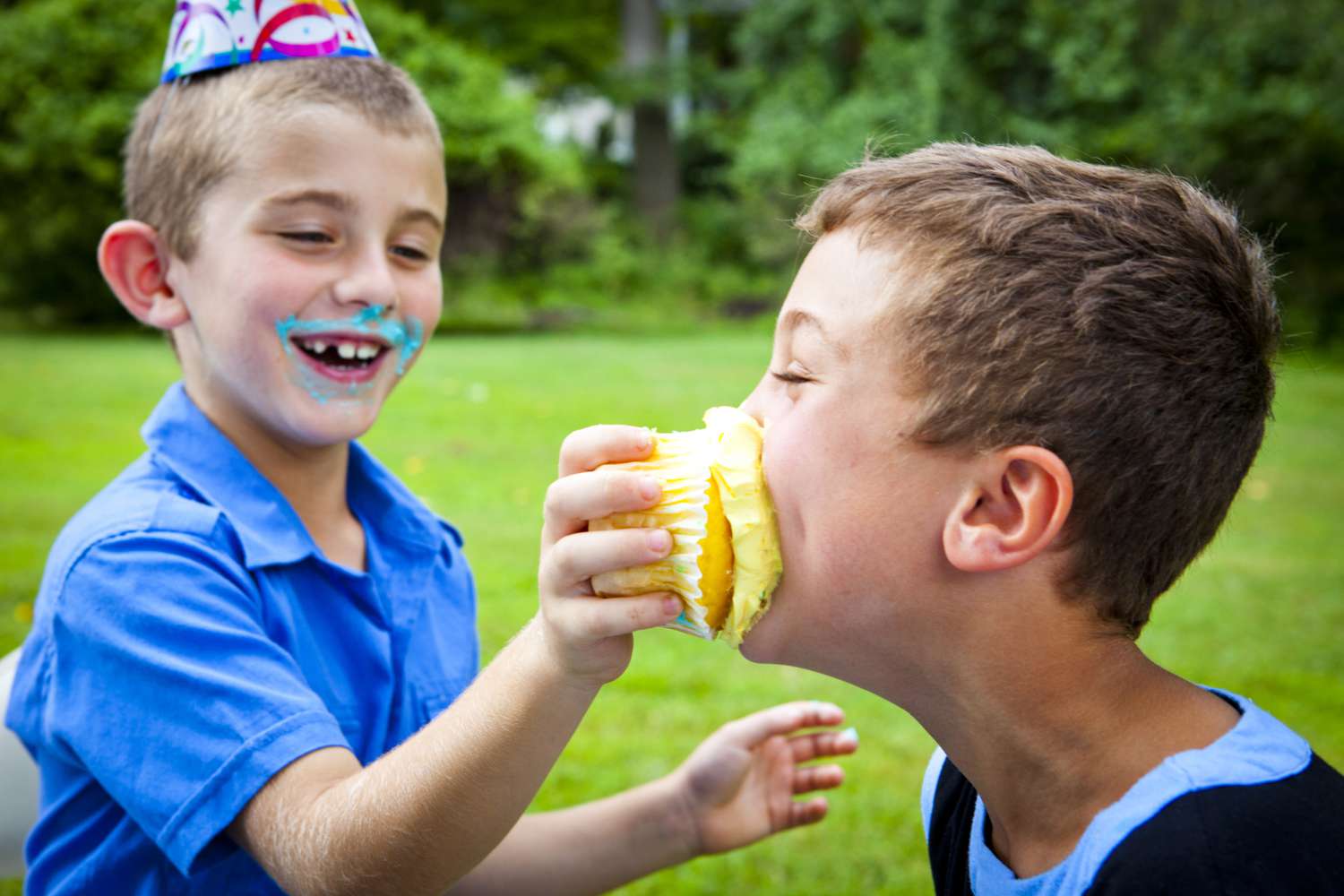Table of Contents
As summer approaches, your children may often find themselves surrounded by tempting sugary treats that can lead to sugar rushes and their associated effects. Managing these sugar rushes is essential for ensuring your child’s well-being.
So, we at Omega Pediatrics made a guide on how to deal with summer sugar rushes in kids so they can have a healthy and enjoyable summer experience.

What and When Does Sugar Rush Occur in Children?
Some kids experience a temporary burst of energy or hyperactivity after consuming sugary foods, known as sugar rushes or “sugar highs.” However, scientific evidence supporting the existence of sugar rushes as a physiological phenomenon is limited.
When your kids consume sugar, it temporarily increases their blood sugar levels, potentially resulting in heightened energy levels. It’s crucial to note that sugar alone is not solely responsible for changes in behavior or hyperactivity in kids.
Factors like excitement, anticipation, or the surrounding environment can also contribute to the perceived effects of sugar. Also, your child’s responses to sugar can vary. While some children may be more sensitive to its effects, others may not exhibit noticeable changes in behavior.
Therefore, your child’s reaction to sugar is unique. Keep in mind the importance of maintaining a balanced diet, and be mindful of how specific foods make your child feel as well.
Tips on How to Minimize Summer Sugar Rush in Kids
As summer rolls around, kids are often exposed to an abundance of sugary treats that can lead to sugar rushes and their associated effects. Managing these sugar rushes is important to ensure your child’s well-being. Here are some tips to avoid the summer sugar rush:
1. Plan Regular Meals and Snacks
Establish a routine to prevent excessive hunger and cravings. Set regular meal and snack times throughout the day to ensure your child’s body is fueled adequately. Skipping meals or going for extended periods without eating can lead to intense hunger and cravings, making it more likely for children to reach for sugary snacks.
Plan nutritious meals and snacks and involve your child in the decision-making process to increase their engagement and satisfaction. Regularly spaced meals and snacks help stabilize blood sugar levels and minimize the desire for quick energy boosts from sugar.
2. Encourage Mindful Eating
Promote mindful eating habits by encouraging them to pay attention to their body’s signals. Teach them to eat when they feel hungry and stop when they feel comfortably satisfied. Encourage them to eat slowly, savoring the flavors and textures of their meals.
By practicing mindful eating, your children can develop a stronger awareness of their body’s needs and avoid overindulging in sugary treats. This mindful approach to eating helps prevent sugar rushes caused by mindless snacking and promotes a healthier relationship with food.
3. Create a Sugar-Free Zone
Establish specific areas where sugary snacks aren’t allowed, like bedrooms or playrooms. Designate certain areas of your home as sugar-free zones to reduce the temptation for constant snacking.
For example, establish a rule that bedrooms or playrooms are off-limits for consuming sugary treats. By setting these boundaries, you create a healthier environment and encourage your child to associate specific areas with nourishing activities rather than mindless snacking.
This approach helps promote mindful eating habits and prevent excessive sugar consumption throughout the day.

4. Keep Healthy Snacks Accessible
Stock up on nutritious options to discourage reaching for sugary snacks. Create a convenient environment that promotes healthy snacking.
Keep a variety of nutritious snacks readily available in your pantry, refrigerator, or snack drawer. Wash and cut fruits and vegetables in advance for easy access. Offer options like yogurt, nuts, whole-grain crackers, or homemade trail mix.
By making healthy snacks easily accessible, you can steer your child away from reaching for sugary alternatives out of convenience. When nutritious options are within reach, they become the default choice, helping to reduce the likelihood of a sugar rush.
5. Offer Frozen Treats
Opt for homemade frozen yogurt or fruit popsicles instead of sugary ice creams. Instead of store-bought ice creams filled with added sugars, consider making your frozen treats using healthier alternatives.
Homemade frozen yogurt or fruit popsicles can be made with fresh fruits, yogurt, and minimal sweeteners. These options are lower in sugar and provide essential nutrients. Also, engage your child in the preparation, allowing them to choose their favorite fruits.
By doing so, kids can enjoy delicious frozen treats without the excessive sugar content found in many commercial products.
6. Teach Moderation
Help children understand that treats can be enjoyed occasionally but not excessively. Let them learn moderation and balance when it comes to sugary treats. Teach them that enjoying desserts or candies in moderation is acceptable, while excessive consumption is detrimental.
Encourage them to savor and appreciate their favorite sweets on special occasions rather than regularly. By instilling the value of moderation, you help your child develop a healthy relationship with sugary treats and prevent the occurrence of overwhelming sugar rushes.
7. Read Labels
Check for hidden sugars in packaged foods and choose low-sugar alternatives. Many processed foods, snacks, and drinks contain hidden sugars. Read food labels and ingredient lists to identify added sugars under various names like corn syrup, fructose, or sucrose.
Opt for healthier alternatives with a lower sugar content or choose whole foods. By being mindful of the hidden sugars in packaged products, you make informed choices and reduce your child’s overall sugar intake, minimizing the risk of sugar rushes and the associated negative effects.
8. Use Natural Sweeteners
Sweeten foods with fruit puree, cinnamon, or vanilla extract instead of refined sugar. When preparing meals or baked goods, consider using natural sweeteners to add flavor. Pureed fruits, such as bananas or applesauce, can be used as a substitute for sugar in recipes.
Additionally, spices like cinnamon or vanilla extract enhance the taste without relying on sugar. These options provide sweetness with nutritional benefits. By incorporating natural sweeteners, you reduce the sugar content of your child’s diet while still satisfying their taste buds.
9. Plan Fun Outdoor Activities
Keep kids occupied and distracted from sugary treats. During the summer, plan outdoor activities that keep your child engaged and entertained. Organize picnics, treasure hunts, or nature walks to provide fun experiences that divert their attention from sugary snacks.
Consider exploring local parks and amusement parks that offer healthy food options, reducing the likelihood of your child seeking sugar-filled treats solely for entertainment. Engaging in outdoor activities provides physical and mental stimulation, effectively regulating their energy levels.
10. Encourage Physical Activity
Engage kids in active play to burn off excess energy. Regular physical activity not only promotes overall health but also helps utilize excess energy that can contribute to sugar rushes. Encourage them to participate in outdoor games, sports, or creative activities that get them moving.
Provide opportunities for active play, such as visits to the park, family bike rides, or swimming. These help regulate blood sugar levels, reduce cravings, and promote a sense of well-being in children.
11. Be Prepared for Outings
Pack healthy snacks and drinks when going out to prevent relying on unhealthy options. When heading out for a day trip, be proactive in packing nutritious snacks and drinks. You can prepare a cooler or bag with sliced fruits, homemade granola bars, or water bottles.
When healthy alternatives are handy, you avoid relying on vending machines or convenience stores that offer sugary snacks and beverages. Planning ensures that your child has nourishing options on hand, minimizing the risk of sugar rushes while on the go.
12. Set a Good Example
Be a role model by consuming healthy foods and beverages yourself. Children learn by observing their parents’ behaviors, so be conscious of your eating habits. Include a variety of nutritious foods in your diet, and choose water or unsweetened drinks over sugary options.
When children see you making healthy choices, they are more likely to follow. Emphasize the importance of balanced meals and demonstrate portion control.
By modeling healthy eating habits, you positively influence your child’s relationship with food and reduce their desire for excessive sugar.
13. Seek Professional Help if Needed
If you have persistent concerns about your child’s sugar intake or their ability to manage sugar rushes, don’t hesitate to seek professional help. Consult a pediatrician or a registered dietitian for guidance.
Omega Pediatrics provides personalized guidance and support. We assess your child’s dietary habits, offer specific recommendations, and help develop a plan tailored to their needs.
Professional guidance ensures that you receive accurate and scientific information and strategies to effectively address and manage your child’s sugar-rush tendencies.

Let Your Kids Have A Healthy, Sugary Summer Experience
Managing the summer sugar rush in kids is crucial for their overall well-being and enjoyment of the season. By implementing these guidelines, you ensure that your child will have a healthy and enjoyable summer experience—free from excessive sugar consumption and its associated effects!
Want more topics on kids’ health? Omega Pediatrics provides informative articles to enrich your parenting journey. After all, we care about you and your kids’ health, especially to enjoy summer while maintaining a healthy lifestyle.
FAQ
What is a sugar rush, and when does it occur in children?
A sugar rush is a temporary burst of energy or hyperactivity that some children experience after consuming sugary foods. While it’s commonly believed to be caused solely by sugar, factors like excitement and environment also play a role.
How can I minimize sugar rushes in my kids during the summer?
Establish regular meal and snack times, encourage mindful eating habits, create sugar-free zones at home, keep healthy snacks accessible, and offer homemade frozen treats as alternatives to store-bought ice cream.
What are some tips for reducing sugar intake in kids?
Read food labels for hidden sugars, use natural sweeteners like fruit puree or cinnamon, plan fun outdoor activities to keep kids occupied, and encourage physical activity to burn off excess energy.
How can I set a good example for healthy eating habits in my children?
Be mindful of your own eating habits, include a variety of nutritious foods in your diet, choose water or unsweetened drinks over sugary options, and demonstrate portion control to positively influence your child’s relationship with food.
When should I seek professional help for managing my child’s sugar intake?
If you have persistent concerns about your child’s sugar intake or their ability to manage sugar rushes, consult a pediatrician or a registered dietitian for personalized guidance and support.



